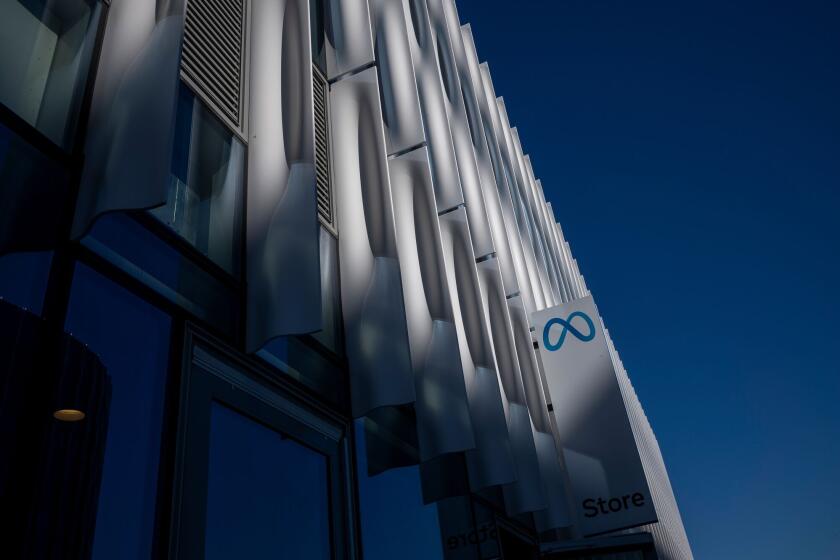Tech Stocks in New Dive on Fears of Slowing Growth
- Share via
NEW YORK — Technology stocks, which soared to unprecedented heights last winter before plummeting in April and May, are in a new sell-off that has already sent many below their spring lows.
But a key difference in this latest plunge is that Wall Street’s worries have nothing to do with rising interest rates or a too-hot economy. This time, it’s all about worries over slowing growth for once invincible high-tech firms.
For the millions of investors who own such premier names as Microsoft, Apple Computer and WorldCom--all of which fell further on Thursday--this second down wave has obliterated billions of dollars in stock wealth.
The trigger for the declines has been a series of warnings from Intel, Dell Computer, Apple and other giants that their sales growth in the near term won’t meet Wall Street’s expectations.
That has been a bitter pill for investors who believed that the tech sector’s growth was all but immune to forces that can brake the rest of the economy.
“This is a reality check that the technology industry is cyclical,” said Arthur Micheletti, chief investment strategist at Bailard, Biehl & Kaiser in San Mateo, Calif.
Indeed, beneath the often conflicting views on the immediate prospects of technology companies there is a building sense that the world is reaching a saturation point for new gizmos that always seem to get smaller, better, cheaper and faster.
A big question for the stock market and the U.S. economy as a whole is whether the resulting slowdown in growth prospects will affect just a few pockets of technology--personal computers, semiconductors, some categories of software--or will envelop the entire tech sector.
As recently as five or six years ago shares of computer-chip makers would tend to be cheaper, relative to the companies’ underlying earnings per share, than the average stock. That was in recognition that the ebbs and flows of the business and its barbaric style of competition made the stocks riskier than average.
But over the last two years investors pushed prices of many chip stocks far higher, relative to earnings, than the average stock--a bet that the companies’ stellar sales and profit growth would go on indefinitely.
Now, falling share prices mean those chip-stock price-to-earnings ratios are coming down again.
High-technology has become so central to the U.S. economy that most analysts doubt we are headed back to the days when the stock of chip maker Intel would trade at a lower price-to-earnings ratio than General Motors.
But what about tech stocks that still have stratospheric valuations? Shares of Sun Microsystems, a maker of high-performance computers, are priced at 83 times the company’s expected earnings per share this year, compared with an average “P/E” of under 30 for the blue-chip Standard & Poor’s 500 companies.
Are the remaining tech high-fliers next in line for a beating?
Internet ‘Build-Out’
Tech-stock enthusiasts insist that there is still explosive growth potential for leading firms involved in, for example, fiber-optic components, wireless communications and what is broadly referred to as the “Internet build-out.”
The stock market is overreacting to “the body language” of recent warnings about profit bumps from companies, while missing the larger picture of continuing long-term growth, said New York money manager Jon M. Burnham.
Consider what happened Thursday to Nextel, a nationwide mobile phone carrier. The stock dropped 12% after the company reported that it had added more than 540,000 subscribers in the United States in the third quarter. Wall Street had been expecting 550,000 new subscribers.
There is no question that the growth rate for mobile-phone sales is declining, said Ed Snyder, an analyst with Chase H&Q.; In 1999, cell phone unit sales increased by 64%. This year they’re expected to rise 51%. Next year, the growth rate could drop below 40%.
But the slower pace is almost meaningless since the actual number of sales is still so large, Snyder said. He estimated that this year 420 million mobile phones will be sold worldwide.
“Two years from now you could be selling a billion phones a year,” he said. “The [growth] rates are declining, but the number of units is just staggering. Everyone is screaming that the world is ending, but really it is just math.”
Yet even die-hard tech-stock fans concede that the personal computer industry is confronting middle age. After nearly 20 years of development, the typical PC is far more powerful than what the average consumer, or even business user, really needs, said Ashok Kumar, analyst with US Bancorp Piper Jaffray.
The result is that companies that used to replace their computers every three years are stretching that out to four years, which also means slower sales growth for computer software, printers and other add-ons.
With computers now found in 45% of households, “penetration in North America is reaching the saturation point,” Kumar said.
Of the 100 million to 115 million PCs sold annually in North America, the vast majority are going to people who already own computers, Kumar said. “There are essentially no new buyers coming in,” he said.
Other areas of technology that have seen phenomenal growth may be approaching a similar phase of evolution.
Not even the Internet is immune.
About 102 million Americans are active users of the Internet, an 8% increase over last year, said Gary Galati, communications director for the technology research firm eMarketer. By 2003, however, when more than half the population is expected to be online, the annual growth rate will begin dropping below 5%, he said.
“The problem is that the [Internet] saturation of the United States came so fast,” Galati said.
And many who do not use the Internet are likely to stay away. A recent study by the Pew Internet and American Life Project found that 57% of those who now have no Internet access have no plans to go online in the future. Nearly one-third--or 31 million Americans--say they “definitely will not” get Internet access, according to the Pew study.
Growth Prospects
Seattle-based money manager William Fleckenstein, a perennial bear--or stock market skeptic--thinks that the few “bulletproof” tech stocks that have dodged most of the tech carnage soon will fall to Earth with the rest.
One stock he expects to tumble is Sun Microsystems. Sun is the dominant producer of high-end computer servers that companies need to conduct Internet commerce. And a big reason for Sun’s amazing recent growth was the willingness of venture capitalists to throw money at dot.com start-ups that in turn became big buyers of Sun products, Fleckenstein said.
But with the bursting of the Internet-stock bubble last winter and spring--the main force behind the March-to-May plunge in the Nasdaq stock index--the easy-money days ended for such fledgling companies. They won’t be buying Sun’s servers at anywhere near the same clip, Fleckenstein argues.
When PC giant Dell Computer warned analysts Wednesday that its third-quarter sales would be slower than expected, it cited problems with European sales brought on by the weak euro currency. But Dell also said sales to small businesses were flagging--a reflection of the tight-money problems Fleckenstein cited.
Michael Murphy, editor of the California Technology Stock Letter, thinks that growth prospects for much of the tech sector remain far better than advertised lately.
If Intel, for example, achieves its now-lowered sales growth target of just 3% in the third quarter, it would still mean record revenues and record profits, Murphy said. Yet Intel’s stock has plunged 44% from the Aug. 31 peak.
“I don’t think I’ve ever seen company managements so confused” as they have been by Wall Street’s recent gloom, Murphy said.
All technology businesses mature eventually and today’s gee-whiz product is tomorrow’s cut-price commodity, but the key is how long it takes to get to that stage, several analysts noted.
There are still many areas of technology that are in just the early phases of development.
Jim Liang, an analyst with W.R. Hambrecht & Co., said optical networking component maker JDS Uniphase, for example, should post annual earnings growth of 50% for the next two years and 35% for several years after that.
“The fiber optic infrastructure build-out is just in the beginning stages unlike the PC market, which is mature,” he said.
Yet JDS Uniphase, which makes lasers and other components for high-speed fiber optic networks, has seen its stock drop from $153 in March to its current price of $95.
Investors have come to see the valuations of the high-fliers as simply out of scale with even the phenomenal growth predicted for the optical market, Liang said.
What remains unclear is how low share prices must go for investors to feel that the stocks again fairly reflect the companies’ prospects.
(BEGIN TEXT OF INFOBOX / INFOGRAPHIC)
Nasdaq Tumbles Again
The Nasdaq composite stock index, dominated by the nation’s biggest technology stocks, is falling sharply again after diving in spring, then recovering somewhat in summer:
Thursday: 3,472.10
Source: Bloomberg News
More to Read
Inside the business of entertainment
The Wide Shot brings you news, analysis and insights on everything from streaming wars to production — and what it all means for the future.
You may occasionally receive promotional content from the Los Angeles Times.










